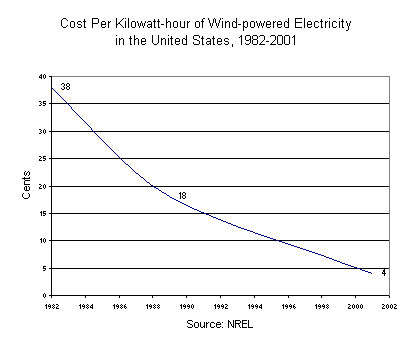Did you know? China is planting a belt of trees to protect land from the expanding Gobi Desert. This Great Green Wall is projected to extend some 4,480 kilometers (2,800 miles), stretching from outer Beijing through Inner Mongolia (Nei Monggol). Unfortunately, recent pressures to expand food production appear to have slowed this tree planting initiative. For more information view the text and data in Chapter 8 of Plan B 4.0: Mobilizing to Save Civilization.
Click here to view the most recent Wind Power Indicator and Data
World wind electric generating capacity climbed from 17,500 megawatts (MW) in 2000 to 24,000 MW in 2001—a dramatic one-year gain of 6,500 MW or 37 percent. As generating costs continue to fall and as public concern about climate change escalates, the world is fast turning to wind for its electricity.
Since 1995, world wind generating capacity has increased an astounding fivefold. In stark contrast, the use of coal—the principal alternative for generating electricity—peaked in 1996 and has declined by 6 percent since then.

One megawatt of wind generating capacity typically will satisfy the electricity needs of 350 households in an industrial society, or roughly 1,000 people. Thus, the 24,000 MW of generating capacity now in place is sufficient to meet the residential electricity needs of some 24 million people—equal to the combined populations of Denmark, Finland, Norway, and Sweden.
In wind electric generating capacity, Germany leads the world with 8,750 MW, more than a third of the total. The United States, which launched the modern wind power industry in California in the early 1980s, follows with 4,250 MW. Spain is in third place, with 3,300 MW. Denmark, which is fourth with 2,400 MW, now gets more than 15 percent of its electricity from wind. Almost two thirds of the capacity added in 2001 was concentrated in the top three countries: Germany added 2,600 MW; the United States, 1,700; and Spain, 930. For the United States, this translates into a growth in generating capacity of some 67 percent in 2001.
Despite this spectacular growth, development of the earth’s wind resources has barely begun. In densely populated Europe, there is enough easily accessible offshore wind energy to meet all of the region’s electricity needs. In the United States, the wind-rich states in the Great Plains have enough harnessable wind energy to meet the country’s electricity needs. And China can easily double its current electricity generation from wind alone.
The cost of wind-generated electricity at prime wind sites has fallen dramatically in the United States over the last 15 years—from 35¢ per kilowatt-hour in the mid-1980s to 4¢ per kilowatt-hour in 2001. (See Figure 2–8.) A few long-term supply contracts have even been signed recently for 3¢ per kilowatt-hour. With the U.S. adoption of a wind production tax credit (PTC) in 1993 to offset established subsidies for oil, coal, and nuclear power, growth surged. New wind farms came online in Colorado, Iowa, Kansas, Minnesota, New York, Oregon, Pennsylvania, Texas, Washington, and Wyoming. In March 2002, the PTC was extended until the end of 2003, setting the stage for continuing rapid growth.
Low-cost electricity from wind brings the option of electrolyzing water to produce hydrogen, which can easily be stored and used to fuel gas-fired turbines in backup power plants when wind power ebbs. Over time, hydrogen produced with wind-generated electricity is the leading candidate to replace natural gas in gas-fired power plants as gas reserves are depleted.
Hydrogen is also the ideal fuel for the fuel-cell engines that every major automobile manufacturer is now working on. Honda and DaimlerChrysler both plan to have fuel-cell-powered vehicles on the market in 2003.
Wind power offers long-term price stability and energy independence. Not only are costs low and falling, but with wind-generated electricity there are no abrupt price hikes, as there are with natural gas. There is no OPEC for wind, because wind is widely dispersed. An inexhaustible source of energy, wind offers more energy than society can use, and it does not disrupt climate.
Copyright © 2002 Earth Policy Institute


 Print:
Print:  Email
Email
